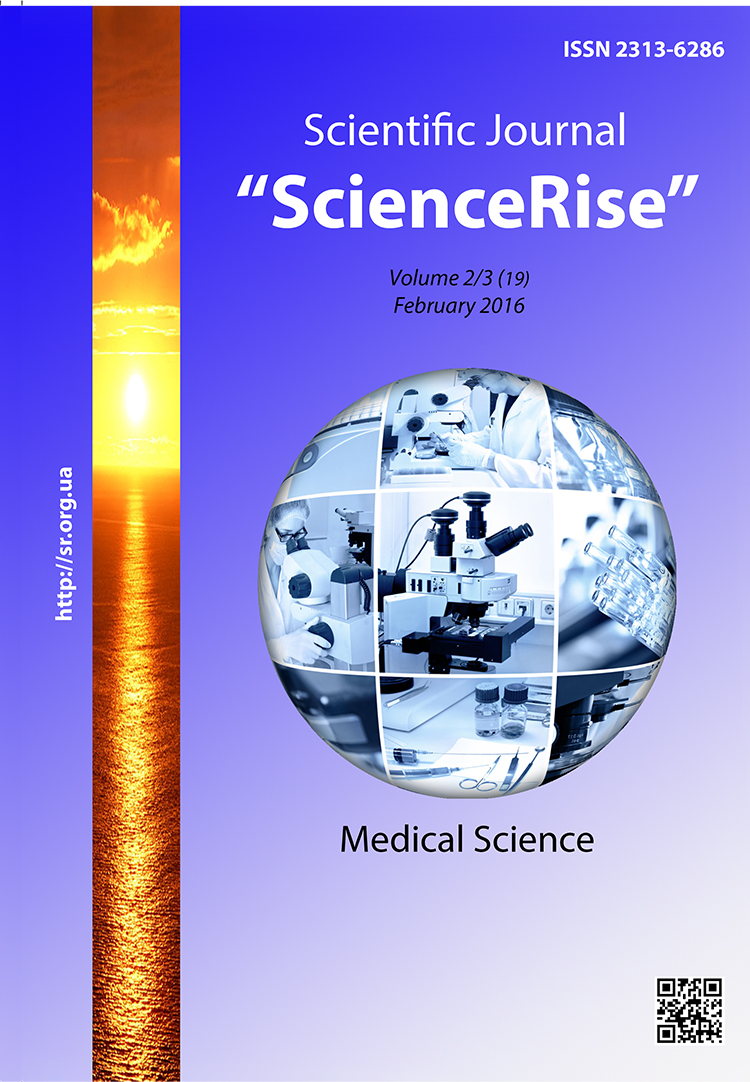Cerebrovascular reactivity in carotid and vertebrobasilar circulative pools at the initial manifestations of chronic cerebral ischemia
DOI:
https://doi.org/10.15587/2313-8416.2016.60858Keywords:
cerebrovascular reactivity, initial manifestations, chronic cerebral ischemiaAbstract
Cerebrovascular pathology is one of the main causes of mortality and disability of population all over the world. It is important not only to reveal the vascular risk factors in proper time but also to define the intensity of its influence on the functional and structural integrity of cerebral vessels.
The aim of research was to study the state and to assess an importance of cerebrovascular reactivity in carotid and vertebrobasilar cerebral pools in patients with initial manifestations of the chronic cerebral ischemia (CCI) depending on the degree of brain lesion.
Materials and methods. We examined 173 persons (44 men and 129 women) of the mean age 50,0±0,46 years old with the initial manifestations of CCI. Patients were divided in two groups depending on the presence of neurovisualizative changes in brain possibly of the vascular origin and the patients of the 2 group were divided in two subgroups (A and B) according to the presence of cerebral atrophy. All patients underwent the general clinical, clinic-neurological, clinic- instrumental and clinic-laboratory examinations. For the study of cerebrovascular reactivity (CVR) in carotid and vertebrobasilar circulatory pools was carried out transcranial duplex scanning using the metabolic tension tests of the different directions.
Results and its discussion. Patients of different groups statistically significantly (р<0,001) differed on indices IR received during metabolic vasodilatatory and vasoconstrictive trials in carotid and vertebrobasilar pools. With the growth of degree of brain lesion at the initial CCI manifestations there was observed the decrease of the reactivity index as the response on metabolic stimuli within autoregulatory diapason in both circulative pools. The response on vasodilatatory tests was less on the force of reaction than the response on vasoconstrictive stimuli. In vertebral arteries (V4) the reaction on metabolic stimuli of different directions (hypercapnia, hypocapnia) was essentially less intensive than in the medial cerebral artery.
Conclusion. The CVR indices in patients with initial CCI manifestations have clinicоdiagnostic importance even within autoregulatory diapason because with approximation of reactivity indices to the one or another limits of diapason we can make suppositions about the degree of tension of the compensatory mechanisms oriented on the support of homeostasis of the central bloodstream in both circulative pools. It is necessary to emphasize that the reactivity of vessels of vertebrobasilar pool was more open to metabolic stimuli comparing with the carotid pool
References
Goff, D. C., Lloyd-Jones, D. M., Bennett, G., Coady, S., D’Agostino, R. B., Gibbons, R. et. al (2013). 2013 ACC/AHA Guideline on the Assessment of Cardiovascular Risk. Circulation, 129 (25), S49–S73. doi: 10.1161/01.cir.0000437741.48606.98
Meschia, J. F., Bushnell, C., Boden-Albala, B., Braun, L. T., Bravata, D. M., Chaturvedi, S. et. al (2014). Guidelines for the Primary Prevention of Stroke. Stroke, 45 (12), 3754–3832. doi: 10.1161/str.0000000000000046
Lelyuk, V. G., Lelyuk S. E. (2002). Metodika ultrazvukovogo issledovaniya sosudistoy sistemyi: tehnologiya skanirovaniya, normativnyie pokazateli. Moscow, 44.
Nezu, T., Yokota, C., Uehara, T., Yamauchi, M., Fukushima, K., Toyoda, K. et. al (2012). Preserved acetazolamide reactivity in lacunar patients with severe white-matter lesions: 15O-labeled gas and H2O positron emission tomography studies. Journal of Cerebral Blood Flow & Metabolism, 32 (5), 844–850. doi: 10.1038/jcbfm.2011.190
McDonnell, M. N., Berry, N. M., Cutting, M. A., Keage, H. A., Buckley, J. D., Howe, P. R. C. (2013). Transcranial Doppler ultrasound to assess cerebrovascular reactivity: reliability, reproducibility and effect of posture. PeerJ, 1, e65. doi: 10.7717/peerj.65
Lelyuk, V. G., Lelyuk, S. E. (2004). Tserebralnoe krovoobraschenie i arterialnoe davlenie. Moscow: Real'noe vremja, 304.
Coverdale, N. S., Badrov, M. B., Shoemaker, J. K. (2016). Impact of age on cerebrovascular dilation versus reactivity to hypercapnia. Journal of Cerebral Blood Flow & Metabolism. doi: 10.1177/0271678x15626156
Sato, K., Sadamoto, T., Hirasawa, A., Oue, A., Subudhi, A. W., Miyazawa, T., Ogoh, S. (2012). Differential blood flow responses to CO 2 in human internal and external carotid and vertebral arteries. The Journal of Physiology, 590 (14), 3277–3290. doi: 10.1113/jphysiol.2012.230425
Lelyuk, S. E., Lelyuk, V. G. (2009). Metodicheskie aspektyi ultrazvukovogo issledovaniya tserebrovaskulyarnoy reaktivnosti v norme i pri ateroskleroticheskom porazhenii braheotsefalnyih arteriy. Moscow: RMAPO, 28.
Fierstra, J., Sobczyk, O., Battisti-Charbonney, A., Mandell, D. M., Poublanc, J., Crawley, A. P. et. al (2013). Measuring cerebrovascular reactivity: what stimulus to use? The Journal of Physiology, 591 (23), 5809–5821. doi: 10.1113/jphysiol.2013.259150
Wardlaw, J. M., Smith, E. E., Biessels, G. J., Cordonnier, C., Fazekas, F., Frayne, R. et. al (2013). Neuroimaging standards for research into small vessel disease and its contribution to ageing and neurodegeneration. The Lancet Neurology, 12 (8), 822–838. doi: 10.1016/s1474-4422(13)70124-8
Downloads
Published
Issue
Section
License
Copyright (c) 2016 Марина Тріщинська Анатоліївна

This work is licensed under a Creative Commons Attribution 4.0 International License.
Our journal abides by the Creative Commons CC BY copyright rights and permissions for open access journals.
Authors, who are published in this journal, agree to the following conditions:
1. The authors reserve the right to authorship of the work and pass the first publication right of this work to the journal under the terms of a Creative Commons CC BY, which allows others to freely distribute the published research with the obligatory reference to the authors of the original work and the first publication of the work in this journal.
2. The authors have the right to conclude separate supplement agreements that relate to non-exclusive work distribution in the form in which it has been published by the journal (for example, to upload the work to the online storage of the journal or publish it as part of a monograph), provided that the reference to the first publication of the work in this journal is included.

